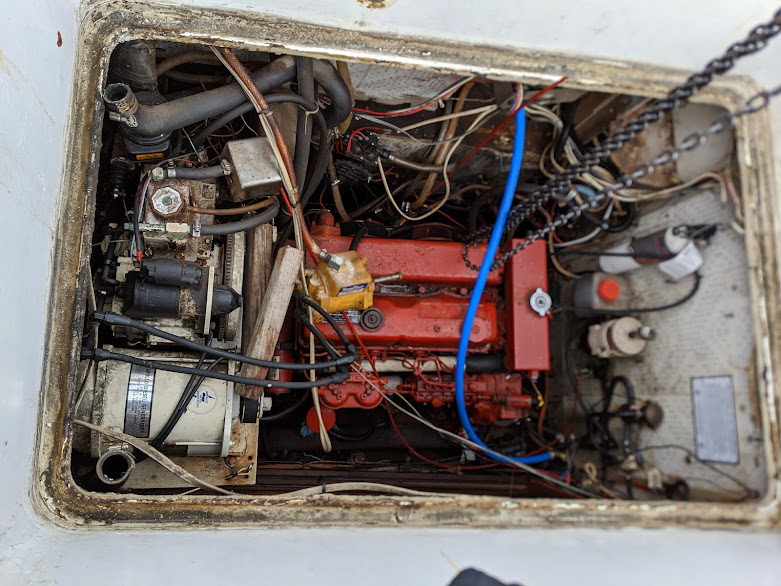Holy Crap! A Toilet!
Wayne's contempt for typical waste handling methods on boats knows no bounds.
We are not squirmish types. Living on a boat requires a greater intimacy with one's humanity and the humanity of those with whom life is shared. There is no escaping any of the bodily functions of those who live on the boat. That said, the components of black water systems are next-level disgusting.
Waste hoses, and even waste holding tanks, invariably become gas-permeable, i.e. gases inside the hoses are able to pass through the hose. It could take years or months, but the gas eventually comes through. Hoses also get a build-up inside them, like plaque in an artery. When the waste system clogs (and it will clog), the hoses generally require disconnection, splattering plaque and black water inside spaces that typically receive little ventilation. The waste tank needs to be emptied and that can be all kinds of adventure depending on the available pump-out facilities. Have you ever seen a pump-out cart spray raw, stewing sewage because of misuse or a parts failure? I have watched people jump into 50F sea water to escape a spraying pump-out cart. Through and through, typical solid sewage handling on a boat is a horror movie come to life.
Wayne has owned this boat for four years without any black water systems. That's a long time to hold it. But seriously, it has been a long run of roughing it.
Before we acquired the new toilet, we removed the old system and all its disgusting parts. Ew. The smell of waste hoses and holding tanks was the main motivation for moving to a composting head. The Lectra-San (white box with blue lid below) is a macerator/treatment system, which chops up the solid waste and then electrochemically treats the water before it is pumped overboard. Besides being stinky, energy inefficient, and maintenance-intensive, Type I MSD are also illegal in Puget Sound.
Even after flushing the lines for weeks, the smell and hose plaque lingers. So gross. Hence the plastic bags covering all the hose ends. Despite cleaning the spaces where the components lived, despite airing them out for one year now, a smelly funk still exists inside the lockers and walls.
Waste hoses, and even waste holding tanks, invariably become gas-permeable, i.e. gases inside the hoses are able to pass through the hose. It could take years or months, but the gas eventually comes through. Hoses also get a build-up inside them, like plaque in an artery. When the waste system clogs (and it will clog), the hoses generally require disconnection, splattering plaque and black water inside spaces that typically receive little ventilation. The waste tank needs to be emptied and that can be all kinds of adventure depending on the available pump-out facilities. Have you ever seen a pump-out cart spray raw, stewing sewage because of misuse or a parts failure? I have watched people jump into 50F sea water to escape a spraying pump-out cart. Through and through, typical solid sewage handling on a boat is a horror movie come to life.
Wayne has owned this boat for four years without any black water systems. That's a long time to hold it. But seriously, it has been a long run of roughing it.
Before we acquired the new toilet, we removed the old system and all its disgusting parts. Ew. The smell of waste hoses and holding tanks was the main motivation for moving to a composting head. The Lectra-San (white box with blue lid below) is a macerator/treatment system, which chops up the solid waste and then electrochemically treats the water before it is pumped overboard. Besides being stinky, energy inefficient, and maintenance-intensive, Type I MSD are also illegal in Puget Sound.
Even after flushing the lines for weeks, the smell and hose plaque lingers. So gross. Hence the plastic bags covering all the hose ends. Despite cleaning the spaces where the components lived, despite airing them out for one year now, a smelly funk still exists inside the lockers and walls.
 |
| No one wants this job. |
The composting toilet is self-contained except for a vent hose that needs to be routed outside the boat well above the water line and a 12V power supply for the keeping the toilet operating aerobically. A small fan draws air from the top of the solid waste container out into the hose, which helps to maintain the correct moisture and temperature levels for composting.
We have a diesel furnace on board that is destined for removal, so we decided to use the existing furnace fresh air intake. Because adding more holes is to be avoided.
 |
| Wayne spends a lot of time upside down in the boat |
 |
| Removing the old furnace intake hoses |
 |
| Test fit successful! |
This install can use a few tweaks that we will discuss in a future post. In that future post, we will also discuss how we feel about it (spoiler alert: it's great!). In the meantime though, we can leave it at:
- we love it
- if you're on the fence about composting toilets or Nature's Head specifically, we can absolutely recommend it
- you already need to be comfortable with your waste products on a boat; the composting toilet reduces the horrors thereof
- it doesn't stink, and I (Wayne) have a very sensitive nose




Comments
Post a Comment